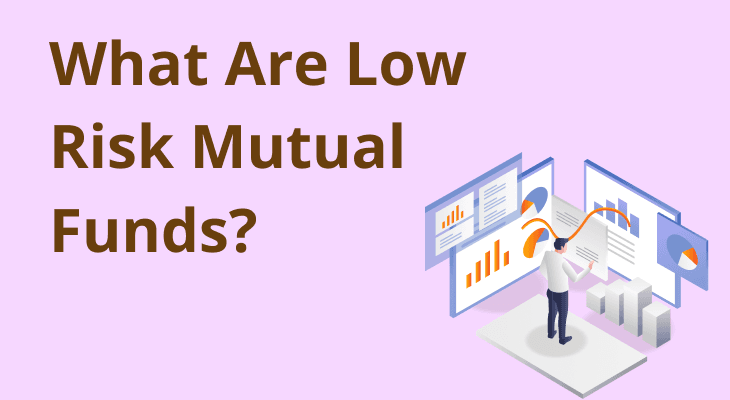
What Are Low Risk Mutual Funds and Who Should Invest In Them?
Investing can feel like a complicated activity, especially for people who are risk-averse or looking to safeguard their capital. For such investors, low-risk mutual funds present an appealing option. These funds focus on generating steady and predictable returns while minimising exposure to market volatility. In this guide, we will explore what low risk mutual funds are, their features, types, and benefits, along with tips on how to invest wisely.
What Are Low Risk Mutual Funds?
Low-risk mutual funds are investment options that put a higher emphasis on stability rather than high returns. These funds invest primarily in low-volatility securities such as government bonds, treasury bills, and high-rated corporate debt instruments. The goal is to provide steady returns while preserving the invested principal, making them an ideal choice for conservative investors. These funds are particularly suited for short-to-medium-term goals, offering a reliable way to grow wealth without significant risk exposure.
Features of Low Risk Mutual Funds
1. Capital Preservation
The primary focus of low risk mutual funds is to preserve the investor's capital. Unlike equity-based funds, which can experience significant fluctuations due to market movements, these funds ensure that the principal amount remains safe while generating modest returns.
2. Predictable Returns
Low risk mutual funds aim to deliver steady and predictable returns over a defined period. Since they primarily invest in fixed-income instruments, they are less susceptible to the volatility of the equity markets, making them more stable.
3. Low Volatility
These funds are less influenced by market downturns or economic turbulence. Their portfolio composition, dominated by debt and money market instruments, ensures that volatility remains minimal.
4. High Liquidity
Most low risk funds allow easy redemption, making them a good choice for individuals seeking short-term parking of funds or requiring quick access to their money in emergencies.
5. Short Investment Horizon
These funds are typically designed for short-to-medium-term investments, with durations ranging from a few days (as in overnight funds) to a few years (as in short-term debt funds).
6. Focus on Quality Instruments
Low risk funds invest in high-quality debt securities like government bonds, treasury bills, and AAA-rated corporate papers. This focus reduces the risk of default.
7. Taxation
The gains on a low risk debt fund are now taxed as per your income tax slab rate, regardless of the holding period.
Types of Low Risk Mutual Funds
Liquid Funds
- Definition: Invest in debt instruments with a maturity of up to 91 days.
- Purpose: Designed for investors looking to park surplus funds temporarily.
- Returns: Offers marginally higher returns than savings accounts while ensuring high liquidity.
Overnight Funds
- Definition: Invest in securities maturing the next day.
- Purpose: Ideal for extremely short-term investments with virtually no credit risk.
- Returns: Provides consistent and stable returns, albeit slightly lower than liquid funds.
Ultra-Short-Term Funds
- Definition: Focus on debt instruments with maturities ranging from 3 to 6 months.
- Purpose: Suitable for investors with slightly longer horizons than liquid funds.
- Returns: Offers higher returns than liquid funds while maintaining low risk.
Money Market Funds
- Definition: Invest primarily in money market instruments like treasury bills, certificates of deposit, and commercial papers.
- Purpose: Offers a balance of liquidity and returns.
- Returns: Competitive returns with minimal risk exposure.
Short-Term Debt Funds
- Definition: Focus on debt instruments with a maturity of 1-3 years.
- Purpose: Ideal for investors seeking stability with medium-term financial goals.
- Returns: Moderately higher returns compared to ultra-short-term funds.
Corporate Bond Funds
- Definition: Invest in highly rated corporate bonds, typically AAA-rated.
- Purpose: Suitable for investors prioritising safety and slightly higher yields.
- Returns: Provides steady returns with moderate risk.
Fixed Maturity Plans (FMPs)
- Definition: Closed-ended schemes with a predetermined maturity date.
- Purpose: Ideal for investors who can stay invested for the fund’s tenure.
- Returns: Predictable returns, depending on the portfolio's underlying instruments.
Benefits of Investing in Low Risk Mutual Funds
- Capital Protection: For risk-averse investors, the assurance of principal safety is a significant advantage. These funds are tailored to minimise the risk of capital erosion.
- Steady Income Stream: low risk mutual funds provide predictable and regular returns, making them suitable for retirees or investors seeking a reliable cash flow.
- Portfolio Stability: Adding low risk funds to a portfolio helps balance out the volatility of high-risk investments like equities.
- High Liquidity: The ability to redeem units quickly provides flexibility, especially for short-term goals or emergencies.
- Tax Efficiency: Debt funds held for over three years qualify for indexation benefits, which reduce taxable income and improve post-tax returns.
- Professional Management: Managed by expert fund managers, these funds allow investors to benefit from professional strategies to maximise returns with minimal risk.
- Diversification: low risk mutual funds offer exposure to a broad spectrum of fixed-income instruments, reducing concentration risk and enhancing the stability of your portfolio.
- Customisable Investment Tenures: With a variety of funds tailored for different horizons (overnight, short-term, or medium-term), these funds cater to various financial goals.
- Suitable for All Investor Profiles: low risk funds are perfect for conservative investors, retirees, or individuals with short-term goals who prefer safety over higher returns.
Risks Associated with Low Risk Mutual Funds
- Credit Risk: Although low risk funds invest in high-quality securities, there’s still a possibility of issuer default, especially in corporate bond or money market funds.
- Interest Rate Risk: Fluctuations in interest rates can impact the returns of these funds. Rising interest rates can lead to a decline in bond prices, affecting NAVs.
- Inflation Risk: Returns from low risk funds may not always outpace inflation, reducing the purchasing power of your investment over time.
- Liquidity Risk: While most low risk funds offer high liquidity, certain funds like fixed maturity plans (FMPs) may have restrictions on redemption before maturity.
- Reinvestment Risk: Investors may face lower returns when reinvesting earnings if interest rates drop during the investment period.
Who Should Invest in Low Risk Mutual Funds?
- Conservative Investors: Ideal for those prioritising safety over high returns.
- Short-Term Savers: Suitable for individuals with financial goals within 1-3 years.
- Retirees: Perfect for generating a steady income without risking their life savings.
- Emergency Fund Builders: A reliable option for maintaining liquidity while earning returns.
- First-Time Investors: Offers a low risk entry point to mutual funds for beginners.
How to Invest in Low Risk Mutual Funds
- Identify Your Goals: Determine your investment horizon and risk tolerance.
- Research Funds: Compare options based on returns, expense ratios, and fund manager expertise.
- Choose a Platform: Invest via online mutual fund platforms like m.Stock or directly via the AMC.
- Select SIP or Lumpsum: Opt for SIPs for regular contributions or lumpsum for one-time investments.
- Review Regularly: Monitor fund performance and make adjustments as needed.
Conclusion
Low risk mutual funds provide a secure and reliable way to grow wealth with minimal risk. While they may not deliver high returns, they ensure stability and capital preservation, making them an excellent choice for risk-averse investors, retirees, and those with short-term goals. By carefully evaluating fund options and aligning them with your financial needs, you can make the most of this investment avenue.
SIPs let you invest small amounts regularly, making it easier to stay consistent with your goals. With time, your money grows faster through compounding, helping you get the most out of your investments. Try our SIP Calculator to see how your money can grow and make smarter plans for your future
FAQ
What are low risk mutual funds?
Low risk mutual funds are investment options that primarily invest in fixed-income instruments such as government bonds, corporate bonds, and money market securities. They aim to provide steady returns with minimal risk.
What are the types of low risk mutual funds?
Different types include liquid funds, gilt funds, ultra-short duration funds, and short-term debt funds. Each caters to different investment horizons and risk preferences.
Are low risk mutual funds suitable for beginners?
Yes, low risk mutual funds are ideal for beginners who seek stable returns with lower than usual exposure to market volatility. They’re a good starting point for those new to investing.
What are the benefits of investing in low risk mutual funds?
These funds offer capital preservation, steady income, liquidity, professional management, and diversification, making them an excellent choice for conservative investors.
Do low risk mutual funds guarantee returns?
No, returns are not guaranteed, but these funds aim to reduce risk by investing in high-quality debt instruments, ensuring more predictable performance.
How do low risk mutual funds compare to fixed deposits?
While fixed deposits offer guaranteed returns, low risk mutual funds can potentially provide better post-tax returns and more liquidity, especially for short-term goals.
What are the risks associated with low risk mutual funds?
Risks include credit risk, interest rate risk, inflation risk, and reinvestment risk. However, these risks are lower compared to equity or high-risk funds.
Who should invest in low risk mutual funds?
Conservative investors, retirees, and individuals with short-term financial goals or a low risk tolerance should consider low risk mutual funds.
How can I invest in low risk mutual funds?
You can invest through online platforms, mutual fund houses, or financial advisors. Decide on the fund type, check past performance, and ensure it aligns with your goals.
Can low risk mutual funds provide high returns?
While their returns are typically stable and lower than equity funds, some funds, like dynamic bond funds, may offer relatively higher returns under favourable market conditions.


